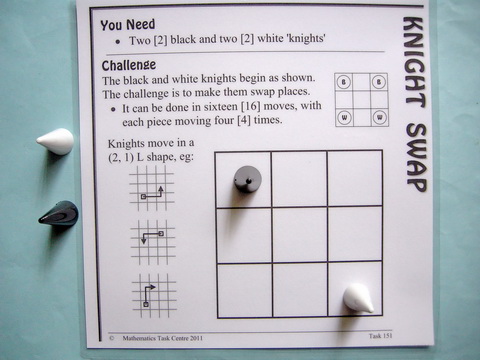
Knight SwapTask 151 ... Years 4 - 8SummaryOne of several chess based problems in the collection, this appears simple, but requires insight. Two black knights begin in the top corners of a 3 x 3 board. Two white knights begin in the bottom corners. The challenge is to make them change sides. A great logic puzzle that involves the concept of rotation. |
Materials
Content
|

IcebergA task is the tip of a learning iceberg. There is always more to a task than is recorded on the card. |
It is very important in this task that the solution is not given away. Why spoil the feeling of achievement that comes from solving it yourself? It also doesn't matter when it is solved, so students are welcome to try, record in their journal what they have tried and come back to it another time. This is the way a mathematician often has to work. If frustration sets in too heavily, some assistance might be necessary.
   
Extensions
|
Whole Class InvestigationTasks are an invitation for two students to work like a mathematician. Tasks can also be modified to become whole class investigations which model how a mathematician works. |
Perhaps the most interesting approach to introducing this problem is to use students as the knights on a large size grid. Girls could be one colour of knight and boys the other. There is no need to solve it this way, but beginning the lesson away from the board in a 'fishbowl' situation, with the physical involvement of some students and mathematical conversation in a group is certainly likely to capture the students' interest. It will also provide the opportunity to demonstrate the meaning of a knight move for those who have less experience with chess. When the challenge is established ask students to return to their seats and tackle the problem in pairs. It's easy to produce grids to match the counters or tiles you have, but if you have Poly Plug it is even easier. A 3 x 3 grid is made in the red board with yellow plugs used on one side and blue on the other. Students keep working on the problem until one pair solves it. Then try to hold back the class grapevine so that others can share the success. Two approaches can help this. Firstly encourage the ones who succeed first to find a way to write out the moves without using a diagram - except perhaps a diagram of a grid to illustrate the grid reference system chosen. Secondly, give the first succeeders permission to help others, if asked, but they must keep their hands behind their back when explaining. When all students are feeling confident with the solution (there may be rotations and reflections, but in essence there is only one solution), demonstrate it and discuss it again on the large grid. Then ask all students to record the solution in their journal. Perhaps they could be asked to produce an animation of the solution. This could be achieved, for example, by using a drawing tool/program to export individual drawings, then gathering them into a slide show program. Round off the lesson by introducing the 4 x 3 challenge above as a voluntary activity, indicating that you would be delighted to see any solutions the students find. Of course family members can help. At this stage, Knight Swap does not have a matching lesson on Maths300. Visit Knight Swap on Poly Plug & Tasks. |
Is it in Maths With Attitude?Maths With Attitude is a set of hands-on learning kits available from Years 3-10 which structure the use of tasks and whole class investigations into a week by week planner. |
The Knight Swap task is an integral part of:
|